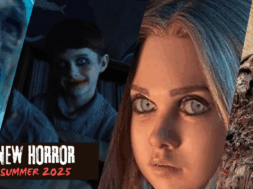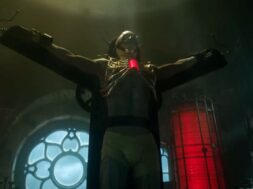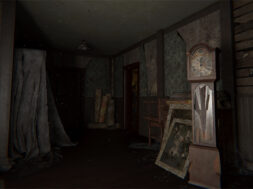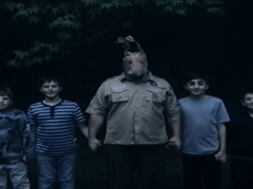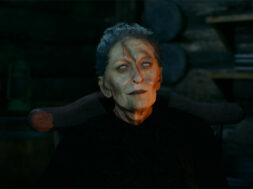[Editorial] With ‘Overlord’ Headed to Theaters, We Revisit the Mystery Box Horrors of J.J. Abrams
J.J. Abrams loves horror. Everything he makes involves horror in some way. Whether it’s a big, lumbering monster spewing back-bursting parasites into the subways of New York or a strange island filled with things that don’t belong, horror is everywhere in Abrams’ filmography. Overlord, Abrams’ latest effort as producer, is no different. It follows a group of American soldiers who are trapped behind enemy lines on the eve of D-Day and forced to fend off mutant creatures that are the results of sinister Nazi experiments. Much like in all of Abrams’ work, the horror of Overlord exists within the unknown. There’s a great moment in the trailer where the camera slowly pushes in on a wall with a series of holes cut out of its surface as strange and horrific noises grow louder and louder. It’s a cool note to end the trailer on but it also speaks to Abrams’ approach to storytelling.
Yes, I’m talking about the mystery box.
Mystery is the engine at the heart of all great horror movies and there are few filmmakers working today who are as fascinated by mystery than J. J. Abrams. From scoring the 1982 film Nightbeast to naming a Star Wars villain Captain Phasma in honor of his love for Phantasm, the influence of horror can be seen across all his work. Abrams’ entire brand of storytelling is cut from the same cloth as some of the best horror movies. His movies aren’t interested in answers; they know that the mystery inherent to questions is the real source of horror. Abrams isn’t interested in what’s inside the box, he understands that not knowing is far more horrifying.
There’s no better example of Abrams “mystery box” storytelling than Lost. It’s a TV show whose questions outnumber the answers and whose fans remain split in half on the quality of its overall six-season run. Think what you want about the show that came after, the pilot of Lost (the only two hours Abrams was involved in directly) is a perfect, self-contained horror movie. For vast chunks of the pilot’s runtime, we are introduced to new characters and shown examples of the island’s mysterious and sinister nature, but there are two particular moments in the episode that emphasize the power of horror.
Early on, the survivors had been attempting to regroup on the beach when something in the woods somewhat damaged their calm. From their vantage point over the rolling hills and jungle of the island, they could see something barreling towards them, leveling huge swaths of the forest in its wake. It’s a terrifying scene where Abrams builds the tension outwards from the characters who argue about where to make camp towards the woods themselves where something wholly different lives. Like the dock attack scene from Jaws, we see the effects of the monster without actually seeing the monster itself, heightening the suspense. While this scene is terrifying in its own right, the sequence that it sets up later in the pilot is a different beast entirely.
The scene in question shows the monster hunting the survivors as they try and recover the pilot from within the cockpit of the downed plane. Once again Abrams is showing the influence of Spielberg on his filmmaking as he creates suspense through a series of escalating reveals. First, we hear the monster roar, then we see its shadows before building to the climactic moment where the unseen beast rips the pilot out of the plane into the jungle. The scene works in a similar way to the T-Rex paddock attack in Jurassic Park, building the suspense slowly by revealing small parts of the creature, leaving its true appearance shrouded in mystery. It’s a testament to Abrams’ approach to the monster that when its true form was revealed, it lost all sense of horror (although that could also be because it looked a bit rubbish).
In Cloverfield, Abrams took the techniques and ideas he’d explored in Lost and combined them with the trappings of Godzilla to create something completely different entirely. Instead of focusing on the monster and those trying to defeat it like they usually do in monster movies, Abrams saw potential horror in keeping the creature hidden and instead focused on the POV of those trying the survive in its wake. Although not directed or written by Abrams, Cloverfield and 10 Cloverfield Lane both have all the trappings of a J. J. Abrams film. Abrams’ central idea for Cloverfield was to take the typical scenes of destruction seen in the Godzilla movies and shift the perspective, placing the viewer into the aftermath; knowing that real horror lies in the chaos created by the attacks. Abrams and Director Matt Reeves sacrificed action in favor of building the suspense, knowing that witnessing the Statue of Liberty’s head being thrown into the street from the perspective of a person on the ground would be scarier than watching the creature rip it off in a wide shot.
And then there’s the subway scene. Like the cockpit sequence from Lost, this scene escalates the horror with a slow series of reveals. The scene begins with strange sounds echoing through the tunnels. Then they see the rats running from something in the darkness. It’s another perfect sequence of horror revealing their situation piece by piece to create suspense until the final night vision payoff.
In the 2001 movie Joy Ride, which Abrams co-wrote, the antagonist is an unseen trucker who lurks in the background much like the monsters of Abrams’ later films. The trucker is an unseen presence whose effects are experienced by the characters, making him an ever-present threat to the protagonists while also keeping his true form hidden from view. Abrams looked to Spielberg’s Duel when writing Joy Ride, attempting to create a villain (voiced by Silence of the Lambs’ Ted Levine) that is less of a physical entity and more of an omnipotent presence within the film.
Everything that J. J. Abrams makes is infused with horror and suspense in some way because his approach to filmmaking has been shaped by the genre. The way Abrams makes movies lends itself perfectly to the horror genre as he withholds information, opting to drip feed the audience details about the monsters slowly through a series of escalating reveals that expertly build suspense. From what we’ve seen so far, Overlord looks set to be the latest in a long line of Abrams projects to use this brand of “mystery box” storytelling.
In his Ted talk on mystery, Abrams talked about how he bought a literal mystery box from a magic store and never opened it. The unopened box is filled with, what Abrams describes as, “infinite possibility and potential” and the same can be said for the darkness within which his onscreen monsters live. J. J. Abrams understands that real horror isn’t the answer to what is inside the box, but rather the unsolved mystery of what it might be.




